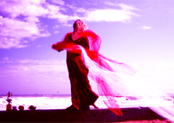OPERA SEARCH

... ce qui arrive...
(2004)text and voice: Paul Auster; song texts: Andrew Patner, Georgette Dee (E-G); film and virtual room: Dominique Gonzales-Foerster
Group I: ssax.tsax.bn-hn.tpt(=picctpt).tbn-perc(1):cym(med)/SD/2crot/glass/tam-t(med)/gong/timp(C)/cowbell/tgl/1tom-t(lg)/1claves-vln;
Group II: fl(=picc).ob.cl(=bcl)-elec.gtr-elec.pft-vla.vlc.db
(ob and hn doubling children's tpt and mouth org);
live-electronics
Abbreviations (PDF)
Bote & Bock
Helmut-List-Halle, Graz
Georgette Dee, special appearance
Conductor: Franck Ollu
Company: Ensemble Modern
In the year 1995, Paul Auster published The Red Notebook, a collection of fifteen pieces of prose dealing with the phenomenon of chance. Throughout our lives, events occur surprisingly and unexpectedly, giving rise to chance structures in the worlds in which we live that we cannot influence. Olga Neuwirth has used several passages from the book for a dramatisation that alternates between music, image and language. The excerpts, read by Paul Auster himself, are about sudden and unexpected turns, the struggle for existence and identity of the young artist in a world made up of chance occurrences. The author’s voice, whose pitch centres around the note D, is embedded in the music of the live ensemble.
In another crucial section of the composition, we hear Georgette Dee’s interpretation of three songs based on texts of her own and Andrew Patner. The small cycle, entitled No more secrets, no more lies, is accompanied by a video by Dominique Gonzales-Foerster, featuring Georgette Dee herself. The flickering image of the singer standing in a flapping red dress on the Lido in Venice is projected both on the canvas and on the musicians’ white dresses.
Through the various media we see different, overlapping levels of inner and outer worlds emerge, thus reflecting the imagination of the main characters of the narrative. While these worlds unfold with great clarity, they are merged in a playful way. Images and music graphically reveal the interplay between perception and memory, and between expectation and imagination – an imagination leading beyond our everyday lives.
steirisc[:her:]bst
“Neuwirth’s “…ce qui arrive…” combines a taped autobiographical monologue spoken by Paul Auster with an orchestral soundscape (performed by the awesome Ensemble Modern) augmented by electronic samples and an amazingly synchronised video [by Dominique Gonzalez-Foerster] of the transgendered chanteuse Georgette Dee… Somewhere over the rainbow of Auster’s banal-sounding fables… the work becomes inexplicably profound… Neuwirth’s music is not easy, but rarely is an intellectual challenge so enjoyable. Her dazzling sonic combinations strike nerves and funny bones.” (Larry L. Lash / James Woodall, Financial Times, 03 Nov 2004)
“Olga Neuwirth has for a long time been Austria’s best, most curious and consequential composer… Paul Auster’s murmurs came from all directions, a recitation virtually on one note that melted again and again blissfully with the sounds of the Ensemble Modern… Neuwirth creates out of Andrew Patner’s poetry three songs à la Kurt Weill in the swell of her rich primeval music… On the video Georgette Dee scrambles in front of the screen, sings, plays with veils, and mutates into a man. Whatever colour appears is overlaid upon the image of the coast that subsequently plunges into darkness. But Olga Neuwirth continually counterpoints the video performer and the suspicion of the cultured person, leading towards the never resting powers of nature…” (Reinhard J. Brembeck, Süddeutsche Zeitung, 23/24 Oct 2004)
“Georgette Dee… seems like an icon of desire, expectation become body and soul. Olga Neuwirth composed three songs for her in the style of Kurt Weill, a study of perfection in terms of their workmanship. In the course of the work the listener is treated to buzzing and clinking noises, sounds as of ice floes superimposing one another – a both tender and harsh cluster symphony with individual melodies bubbling to the surface in between. If listeners are ready to act as resonators, an existential experience awaits them, which is no less than a life poised between happiness and disaster, hope and desperation, transposed into the realm of art.” (Ulrich Weinzierl, Die Welt, 04 Nov 2004)
Poetic
